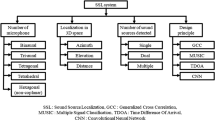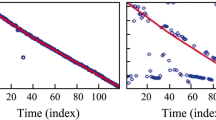Abstract
The present research investigates the innovative concept of LMS adaptive noise cancellation by means of a modified algorithm using an LMS adaptive filter along with their detailed analysis. Three types of equations viz. output, error, and weight update are used in the LMS algorithm. The error equation of traditional LMS algorithm is modified which gives better results as compared to traditional LMS algorithm and their types. The comparison parameters used in the present analysis are signal-to-noise ratio, mean square error, maximum absolute error, and energy ratio between signals of error and output signals. The proposed modified model was found to have a higher signal-to-noise ratio with respect to the traditional model of LMS adaptive noise cancellation. The signal-to-noise ratio of the proposed model has also been compared with some other types of LMS algorithms and was found better in most of the cases.









Similar content being viewed by others
References
W.M. Abd-Elhameed, E.H. Doha, Y.H. Youssri, New wavelets collocation method for solving second-order multipoint boundary value problems using Chebyshev polynomials of third and fourth kinds. Abstr. Appl. Anal. 2013, 1–9 (2013). https://doi.org/10.1155/2013/542839
Y. Chen, Y. Gu, A. O. Hero, Sparse LMS for system identification, in IEEE International Conference on Acoustics, Speech and Signal Processing, pp. 3125–3128 (2009). https://doi.org/10.1109/ICASSP.2009.4960286
Y.R. Chien, W.J. Tseng, A new variable step-size method for the M-max LMS algorithms, in IEEE International Conference on Consumer Electronics, Taiwan, pp. 21–22 (2014). https://doi.org/10.1109/ICCE-TW.2014.6904062
R. Dallinger, M. Rupp, On robustness of coupled adaptive filters, in IEEE International Conference on Acoustics, Speech and Signal Processing, Taiwan, pp. 3085–3088 (2009). http://doi.ieeecomputersociety.org/10.1109/ICASSP.2009.4960276
R. Dallinger, M. Rupp, On the robustness of LMS algorithms with time-variant diagonal matrix step-size, in IEEE International Conference on Acoustics, Speech and Signal Processing, Canada, pp. 5691–5695 (2013). https://doi.org/10.1109/ICASSP.2013.6638754
M. Dhal, M. Ghosh, P. Goel, A. Kar, S. Mohapatra, M. Chandra, An unique adaptive noise canceller with advanced variable-step BLMS algorithm, in IEEE International Conference on Advances in Computing, Communications and Informatics, India, pp. 178–183 (2015). https://doi.org/10.1109/ICACCI.2015.7275605
S. Dixit, D. Nagaria, Design and analysis of cascaded LMS adaptive filters for noise cancellation. Circuits Syst. Signal Process. 36(2), 742–766 (2017). https://doi.org/10.1007/s00034-016-0332-5
S. Dixit, D. Nagaria, Hardware reduction in cascaded LMS adaptive filter for noise cancellation using feedback, in Circuits Systems and Signal Processing, pp. 1–16 (2018). https://doi.org/10.1007/s00034-018-0896-3
S. Dixit, D. Nagaria, Neural network implementation of least-mean-square adaptive noise cancellation, in IEEE International Conference on Issues and Challenges in Intelligent Computing Techniques, pp. 134–139 (2014). https://doi.org/10.1109/ICICICT.2014.6781266
S.C. Douglas, Performance comparison of two implementations of the leaky LMS adaptive filter. IEEE Trans. Signal Process. 45(8), 2125–2129 (1997). https://doi.org/10.1109/78.611231
F. Faccenda, L. Novarini, An amplitude constrained FxLMS algorithm for narrow-band active noise control applications, in IEEE 9th International Symposium on Image and Signal Processing and Analysis, Croatia, pp. 233–237 (2015). https://doi.org/10.1109/ISPA.2015.7306064
D.A. Florêncio, H.S. Malvar, Multichannel filtering for optimum noise reduction in microphone arrays, in IEEE International Conference on Acoustics, Speech, and Signal Processing, USA, pp. 197–200 (2001). https://doi.org/10.1109/ICASSP.2001.940801
J.M. Górriz, J. Ramírez, S. Cruces-Alvarez, C.G. Puntonet, E.W. Lang, D. Erdogmus, A novel LMS algorithm applied to adaptive noise cancellation. IEEE Signal Process. Lett. 16(1), 34–37 (2009). https://doi.org/10.1109/LSP.2008.2008584
T. Gowri, P.R. Kumar, D.R.K. Reddy, An efficient variable step size least mean square adaptive algorithm used to enhance the quality of electrocardiogram signal, in S.M. Thampi, A. Gelbukh, J. Mukhopadhyay (eds.) Advances in Signal Processing and Intelligent Recognition Systems, pp. 463–475. Springer, Cham (2014). https://doi.org/10.1007/978-3-319-04960-1_41
J.G. Harris, J.K. Juan, J.C. Principe, Analog hardware implementation of continuous-time adaptive filter structures. Analog Integr. Circ. Sig. Process 18(2–3), 209–227 (1999). https://doi.org/10.1023/A:1008363406175
S. Haykin, B. Widrow, Least-mean-square adaptive filters (Wiley, New York, 2003)
S.S. Haykin, Adaptive filter theory (Pearson Education India, Delhi, 2008)
J.H. Husøy, M.S.E. Abadi, Unified approach to adaptive filters and their performance. IET Signal Proc. 2(2), 97–109 (2008). https://doi.org/10.1049/iet-spr:20070077
S.M. Jung, J.H. Seo, P. Park, Efficient variable step-size diffusion normalised least-mean-square algorithm. Electron. Lett. 51(5), 395–397 (2015). https://doi.org/10.1049/el.2014.4061
M. Kalamani, S. Valarmathy, M. Krishnamoorthi, Adaptive noise reduction algorithm for speech enhancement. World Acad. Sci. Eng. Technol. Int. J. Electr. Comput. Ener. Electr. Commun. Eng. 8(6), 1007–1014 (2014)
N. Kalouptsidis, S. Theodoridis, Adaptive system identification and signal processing algorithms (Prentice-Hall, Inc., Upper Saddle River, 1993)
A. Kar, M. Chandra, Pseudo-fractional tap-length learning based applied soft computing for structure adaptation of LMS in high noise environment, in S. Patnaik, B. Zhong (eds.) Soft Computing Techniques in Engineering Applications, pp. 115–129. Springer, New York (2014). https://doi.org/10.1007/978-3-319-04693-8_8
S. Kim, C.D. Yoo, T.Q. Nguyen, Alias-free subband adaptive filtering with critical sampling. IEEE Trans. Signal Process. 56(5), 1894–1904 (2008). https://doi.org/10.1109/TSP.2007.912262
J. Krolik, M. Joy, S. Pasupathy, M. Eizenman, A comparative study of the LMS adaptive filter versus generalized correlation method for time delay estimation. IEEE Int. Conf. Acoust. Speech Signal Process. 9, 652–655 (1984). https://doi.org/10.1109/ICASSP.1984.1172302
H.S. Lee, S.E. Kim, J.W. Lee, W.J. Song, A variable step-size diffusion LMS algorithm for distributed estimation. IEEE Trans. Signal Process. 63(7), 1808–1820 (2015). https://doi.org/10.1109/TSP.2015.2401533
W.C. Lee, C.C.J. Kuo, Musical onset detection based on adaptive linear prediction, in IEEE International Conference on Multimedia and Expo, pp. 957–960 (2006). https://doi.org/10.1109/ICME.2006.262679
F. Liu, W. Yuan, Y. Ma, Y. Zhou, H. Liu, New enhanced robust kernel least mean square adaptive filtering algorithm, in International Conference on Estimation, Detection and Information Fusion, China, pp. 282–285 (2015). https://doi.org/10.1109/ICEDIF.2015.7280207
P.L. Madhuri, A.A. John, A fast convergence VSS-SDSELMS adaptive channel estimation algorithm for MIMO-OFDM system, in IEEE International Conference on Control, Instrumentation, Communication and Computational Technologies, pp. 98–103 (2015). https://doi.org/10.1109/ICCICCT.2015.7475257
A.K. Maurya, Cascade-cascade least mean square (LMS) adaptive noise cancellation. Circuits Syst. Signal Process. 37(9), 3785–3826 (2018). https://doi.org/10.1007/s00034-017-0731-2
K. Mayyas, T. Aboulnasr, Leaky LMS algorithm: MSE analysis for Gaussian data. IEEE Trans. Signal Process. 45(4), 927–934 (1997). https://doi.org/10.1109/78.564181
F. Merrikh-Bayat, S. Bagheri-Shouraki, Mixed analog-digital crossbar-based hardware implementation of sign-sign LMS adaptive filter. Analog Integr. Circ. Sig. Process 66(1), 41–48 (2011). https://doi.org/10.1007/s10470-010-9523-3
J. Ni, J. Chen, X. Chen, Diffusion sign-error LMS algorithm: formulation and stochastic behavior analysis. Sig. Process. 128, 142–149 (2016). https://doi.org/10.1016/j.sigpro.2016.03.022
B. Paul, P. Mythili, ECG noise removal using GA tuned sign-data least mean square algorithm, in IEEE International Conference on Advanced Communication Control and Computing Technologies, pp. 100–103 (2012). https://doi.org/10.1109/ICACCCT.2012.6320750
P. Prandoni, M. Vetterli, An FIR cascade structure for adaptive linear prediction. IEEE Trans. Signal Process. 46(9), 2566–2571 (1998). https://doi.org/10.1109/78.709548
N.G. Prelcic, F.P. González, M.E.D. Jiménez, Wavelet packet-based subband adaptive equalization. Sig. Process. 81(8), 1641–1662 (2001). https://doi.org/10.1016/S0165-1684(01)00077-9
H. Quanzhen, G. Zhiyuan, G. Shouwei, S. Yong, Z. Xiaojin, Comparison of LMS and RLS algorithm for active vibration control of smart structures. IEEE Third Int. Conf. Meas. Technol. Mechatron. Autom. 1, 745–748 (2011). https://doi.org/10.1109/ICMTMA.2011.188
L. Rugini, G. Leus, Basis expansion adaptive filters for time-varying system identification, In 2nd IEEE International Workshop in Computational Advances in Multi-Sensor Adaptive Processing, pp. 153–156 (2007)
A.H. Sayed, Adaptive filters (Wiley, New York, 2011)
M. Soflaei, P. Azmi, E. Mostajeran, Using selective partial update-selective regressor affine projection algorithms for adaptive equalization in underwater acoustic communications, in International Conference of Information and Communication Technology, pp. 372–376 (2013). https://doi.org/10.1109/ICoICT.2013.6574604
K.L. Sudha, Performance analysis of new time-varying LMS (NTVLMS) adaptive filtering algorithm in noise cancellation system, in IEEE International Conference on Communication, Information & Computing Technology, India, pp. 1–6 (2015). https://doi.org/10.1109/ICCICT.2015.7045710
B. Widrow, E. Walach, Adaptive signal processing for adaptive control, in IEEE International Conference on Acoustics, Speech, and Signal Processing, USA, pp. 191–194 (1984). https://doi.org/10.1016/S1474-6670(17)62348-6
B. Widrow, J.M. McCool, M.G. Larimore, C.R. Johnson, Stationary and nonstationary learning characteristics of the LMS adaptive filter. Proc. IEEE 64(8), 1151–1162 (1976). https://doi.org/10.1109/PROC.1976.10286
B. Widrow, J.R. Glover, J.M. McCool, J. Kaunitz, C.S. Williams, R.H. Hearn, J.R. Zeidler, J.E. Dong, R.C. Goodlin, Adaptive noise cancelling: principles and applications. Proc. IEEE 63(12), 1692–1716 (1975). https://doi.org/10.1109/PROC.1975.10036
T. Xu, G. Jacobsen, S. Popov, J. Li, K. Wang, A.T. Friberg, Normalized LMS digital filter for chromatic dispersion equalization in 112-Gbit/s PDM-QPSK coherent optical transmission system. Opt. Commun. 283(6), 963–967 (2010). https://doi.org/10.1016/j.optcom.2009.11.011
N.R. Yousef, A.H. Sayed, Fixed point steady-state analysis of adaptive filters. Int. J. Adapt. Control Signal Process. 17(3), 237–258 (2003). https://doi.org/10.1002/acs.738
C.H. Zhao, Y. Du, Blind recognition algorithm of mixed MPSK signals based on constellation diagram. J Eng 2012(4), (2012)
Author information
Authors and Affiliations
Corresponding author
Appendix
Appendix
1.1 LMS Algorithms for Adaptive Filters
The output signal y(n) and error signal e(n) for the adaptive filter is given in Eqs. (1) and (2), respectively. The different types of LMS algorithms are known by their weight updated algorithms.
1.1.1 Weight Updated Algorithms
The different types of weight updated algorithms are described as follows:
1.1.1.1 Traditional LMS Algorithm
where W(n) = [w0(n) w1(n) … wL−1(n)]T is the weight coefficient vector, X(n) = [x(n) x(n − 1) … x(n − L + 1)]T is the input signal vector, e(n) is the error signal, μ is the step size and L is the filter length of LMS adaptive filter and 0 < µ < 1/λmax.
The λmax is the maximum eigenvalue of correlation matrix Rx. Here,
1.1.1.2 Normalized LMS (N-LMS) Algorithm
where 0 < β < 2, \( {\left\|{X\left( n \right)^{2} }\right\|} = X^{\text{T}} \left( n \right) {X\left( n \right)} \) and \( \mu = \frac{\beta }{{\left\|{X\left( n \right)^{2} }\right\|}} \)
1.1.1.3 Modified Normalized LMS (MN-LMS) Algorithm
where ε = small positive number.
1.1.1.4 Leaky LMS (L-LMS) Algorithm
where leaky coefficient γ, 0 < γ ≪ 1 and 0 < µ < (γ + λmax).
1.1.1.5 Block LMS (B-LMS) Algorithm
It is also known as block-updating LMS algorithm. The filter coefficients are updated only once for each block of L-samples. The output signal of a kth block of LMS filter,
The error signal of kth block of LMS filter,
The weight updated algorithm of kth block of LMS filter,
where l = 0, 1, 2,…, L − 1.
1.1.1.6 Sign-Error LMS (SE-LMS) Algorithm
where sgn(.) = signum function
1.1.1.7 Sign-Data LMS (SD-LMS) Algorithm
1.1.1.8 Sign-Data-Normalized LMS (SDN-LMS) Algorithm
1.1.1.9 Sign-Sign LMS (SS-LMS) Algorithm
1.1.1.10 Sign-Sign LMS Algorithm with Leakage Term (SS-LMS-LT)
1.1.1.11 Variable Step-Size LMS (VS-LMS) Algorithm
where µmin < µ < µmax and step size adjusted for each coefficient.
Rights and permissions
About this article
Cite this article
Maurya, A.K., Agrawal, P. & Dixit, S. Modified Model and Algorithm of LMS Adaptive Filter for Noise Cancellation. Circuits Syst Signal Process 38, 2351–2368 (2019). https://doi.org/10.1007/s00034-018-0952-z
Received:
Revised:
Accepted:
Published:
Issue Date:
DOI: https://doi.org/10.1007/s00034-018-0952-z




